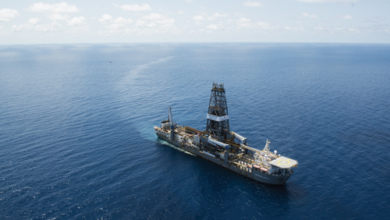Measurements of NOx, soot and non-combusted methane were collected over progression of engine loads, speeds
from 1,500-1,950 RPM
By Carolyn LaFleur, Asanga Wijesinghe, Richard Haut, Environmentally Friendly Drilling Systems Program, Houston Advanced Research Center
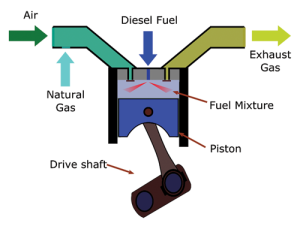
As the reality of America’s natural gas age comes into view, more of the equipment used to produce that gas will also be powered by it. As a cleaner fuel, natural gas offers the promise of reducing emissions, site footprint and cost. Natural gas is displacing diesel fuel in reciprocating engines and firing turbines, providing power for upstream development. The potential for gas fuel to power drilling and hydraulic fracturing brings with it a number of technical and operational challenges.
With partners in industry and academia, the Environmentally Friendly Drilling Systems Program (EFD) is exploring engine technologies, fueling systems, industry trends and regulatory issues. EFD is a research program of the Houston Advanced Research Center (HARC), an independent research hub providing scientific analysis on energy, air and water issues. EFD is focused on unbiased science to address environmental aspects of oil and gas exploration and production by engaging university researchers, national laboratories, governmental and non-governmental groups and industry.
The increased availability and utilization of natural gas led to an ongoing EFD research initiative, “Powered by Natural Gas,” established in 2013 and dedicated to the study of utilizing natural gas as a primary fuel source for equipment used in drilling and hydraulic fracturing.
With a sense of urgency to capitalize on the economic and environmental benefits of gas fuel, operators and service companies are seeking answers even as the questions change. Understanding the state of development for these technologies can inform decisions about investment and policy in the near and long term. Dual fuel is one such technology. As dual-fuel engines were gaining acceptance, many industry sources reported significant emissions benefits and cost savings. Others reported natural gas use and costs were higher than expected. However, there was little data or specific information available about these issues in practice. A number of industry partners expressed interest in better understanding these attributes, so EFD researchers set about conducting field trials to directly measure emissions, fuel consumption and other relevant parameters. These and other field trials are part of the EFD Technology Integration Program, with funding support from the US Department of Energy through the Research Partnership to Secure Energy for America.
Natural gas fuel may be delivered to the site as liquefied natural gas or compressed natural gas. Field gas can also be used with suitable conditioning.
How dual fuel works
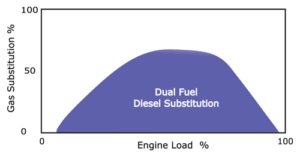
Dual-fuel engines are essentially diesel engines that have been adapted to utilize gas together with diesel fuel, thereby displacing some of the diesel fuel. These engines have the flexibility to run solely on diesel fuel alone when gas is unavailable, making them reliable and versatile. In dual-fuel engines, natural gas fuel in vapor phase is introduced into the air intake system of the engine in a process known as fumigation (Figure 1). The two fuels are blended together and ignited by compression in the engine cylinder.
Dual fuel in this configuration offers many of the operational advantages of conventional diesel power. In particular, dual fuel offers transient load response similar to diesel, important for drilling and hydraulic fracturing, and have been shown to function well in these applications. In this article, we examine the emissions and fuel consumption characteristics of a dual-fuel diesel engine.
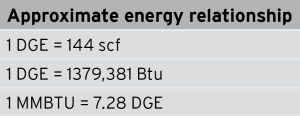
Fumigation systems are available as aftermarket retrofit kits for existing diesel engines or as part of an original equipment manufacturer package. There are important Environmental Protection Agency regulations concerning the certification of diesel engines to meet emissions standards. These emissions standards pertain to diesel engines, even when fitted with dual-fuel capability.
Natural gas fuel can be substituted for diesel fuel in varying proportions according to a given set of operating parameters, including engine speed and load. Natural gas fuel substitution for dual-fuel applications can be expressed in terms of the diesel gallon equivalent, or the amount of energy provided by natural gas in comparison with a gallon of diesel fuel. The testing described in this article utilized gas provided from a municipal gas supply, with an average gross heating value of 1,028 Btu/cu ft.
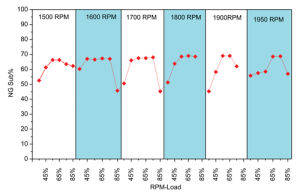
In addition to methane, gas available for use in the field may contain other hydrocarbon compounds of higher heating value, thereby increasing the overall heating value of the supply gas. In many instances, field gas must be conditioned for use as fuel by removing liquids and stabilizing the Btu content. A growing number of fueling technologies can be utilized for this purpose.
The expanded use of natural gas fuel in dual-fuel diesel engines, dedicated gas engines and turbines is driving advances in fueling systems to condition and deliver gas to power oilfield operations. Utilizing gas near the point of production offers significant economic and environmental benefits by eliminating conventional gathering, processing, transport and distribution.
The amount of energy supplied by gas fuel, expressed as a percentage of the total energy that would be provided as diesel fuel, is known as the substitution rate. Dual fuel substitution is optimized with a system of sensors and control logic integral to the engine equipment package or aftermarket retrofit kit. Although many factors such as engine speed and load affect substitution, rates of 50% to 70% gas have been observed. Figure 2 illustrates possible substitution rates of natural gas for a typical high-horsepower operating range. There is an optimal range of engine load at which gas substitution is maximized, sometimes known as the sweet spot. At the low end and high end of the load spectrum, gas substitution is decreased to zero.
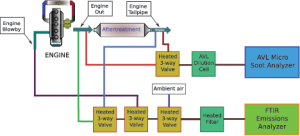
Substitution rate data are obtained from the engine control unit (ECU), the programmed electronic component that controls various engine functions based on a number of sensor readings. The plots in Figure 3 depict substitution rates over a range of engine speeds and loads in the test. Notably, the shape of these plots shows the characteristic maximum substitution trend at a midrange of engine load. In this range, a sustained substitution rate of 65% to 70% was observed.
As dual fuel came into use for drilling and hydraulic fracturing, some users found that the amount of natural gas actually used was greater than expected based on the substitution rate. This differential was thought to be due to thermal efficiency losses, incomplete combustion of the gas or possibly errors associated with fuel measurement methods. Since not all of the energy provided by the gas was being used, the actual amount of diesel displaced was somewhat less than predicted by substitution rate, affecting overall fuel economy.
Understanding emissions
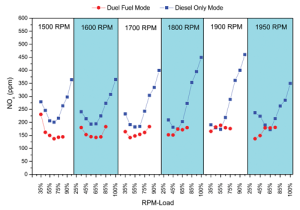
Of particular interest are oxides of nitrogen (NOx) and particulate matter (PM) that have long been a concern with diesel engine emissions. Aftertreatment is required to attain compliance with emissions standards for certain criteria pollutants. Diesel oxidation catalysts (DOC) or selective catalytic reduction (SCR) can be incorporated as part of the engine exhaust system to provide effective treatment of these substances. As with other technologies evolving to optimize dual-fuel performance, DOC and SCR systems are being improved to more effectively treat emissions associated with dual fuel. Crankcase blow-by emissions are also of interest. Although the amount of crankcase emissions are much smaller than the tailpipe, these emissions may receive no treatment prior to being released into the atmosphere.
With regulation of greenhouse gases on the horizon, the potential for emissions of non-combusted methane (NCM), sometimes referred to as methane slip, is a concern. As a greenhouse gas, methane is many times more potent than carbon dioxide (CO2). Although it is known that NCM can be emitted from dual-fuel combustion, the amount of methane emitted was less clear. As with other emissions parameters, NCM amounts will vary as a function of engine speed and load, as well as other factors.
Instrumentation and testing
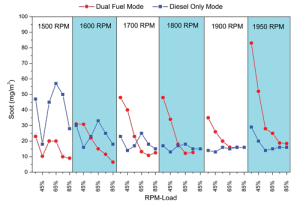
Using state-of-the-art emissions analyzers, EFD researchers conducted tests on a dual-fuel high-horsepower engine in hydraulic fracturing service. Gaseous emissions were measured using Fourier transform infrared spectroscopy. Soot, the main component of PM, was measured in real time and correlated with measurements of gaseous emissions. These measurements were conducted over a progression of engine loads and range of engine speeds from 1,500 to 1,950 RPM.
The subject hydraulic fracturing pump was located at a test facility. Load was induced on the pump by the circulating pressurized fluid through a test loop. Sampling probes were installed both upstream (engine out) and downstream (tailpipe) of the aftertreatment system. This was done to analyze the effectiveness of the aftertreatment in treating the exhaust stream to remove pollutants prior to discharging to atmosphere. Samples of the exhaust stream were conveyed using heated sampling line to prevent condensation during transit to the analyzers. Data from the ECU was logged throughout the test and correlated with analytical measurements.
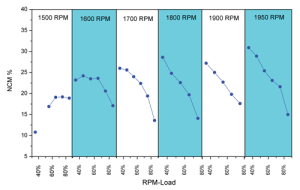
The instrumentation package was housed in an intrinsically safe enclosure suitable for use in an environment where hydrocarbon vapor may be present, allowing researchers to test at a well location. HARC EFD has an ongoing program of emissions measurements in the field, continuing to collect data on different types of engines in oilfield applications. Studies to collect data on dual-fuel engines in drilling service are being planned for this year.
Emissions measurements
Among gaseous emissions, NOx is significant in that it is regulated for diesel engines, including dual-fuel engines. Proponents of dual fuel have touted reduced emissions of NOx as an advantage over conventional diesel. In these measurements, emissions of NOx were indeed lower in dual-fuel mode compared with diesel-only mode. This advantage in reduced NOx was most distinct at loads greater than 50%, as illustrated in Figure 5.
Soot is the main component of PM, consisting of solid carbon that typically comprises 70% or more of the PM mass, with the remaining mass consisting of soluble organics. Soot measurements do not distinguish particle size. However, this method affords a real-time measurement that can be correlated with gaseous emissions. These results were mixed. Soot was lower in dual-fuel mode for all loads at 1,500 RPM but higher at 1,950 RPM. At speeds from 1,600 to 1,900 RPM, soot was generally lower for dual fuel at higher loads (above 50%) although similar or higher for lower loads (below 50%). These results, illustrated in Figure 6, may be due in part to incomplete combustion of the dual-fuel mixture.
It is generally known that some amount of the gas fuel may not be burned in the engine and is emitted with other exhaust gases as NCM. Quantifying NCM can inform understandings of fuel economy and greenhouse gas emissions. Amounts of methane in the tailpipe exhaust and crankcase emissions were measured and compared with the total flow of gas fuel to the engine. For the conditions of this test, it was found that the amount of NCM was as much as 30% of the natural gas supplied to the engine, generally diminishing at higher loads. These results are shown in Figure 7.
Many factors affect combustion stability and relative completeness of combustion of the two fuels. Incomplete combustion that results in NCM may be due to a number of factors. The two fuels have distinctly different combustion characteristics. The diesel fuel auto-ignites first, as a pilot that then ignites the natural gas. Incomplete mixing of the gas and air by the fumigation process may contribute to less-than-optimal combustion in the cylinder. There may be other factors contributing to incomplete combustion of the gas, having to do with cylinder/piston geometry and boundary effects. Recognizing that NCM is an issue, manufacturers of engines, dual-fuel kits and aftertreatments are working to improve these systems to more efficiently utilize the gas and reduce emissions, including methane.
Results of studies such as these can better inform users about the economics and emissions characteristics of dual-fuel engines. Dual-fuel engines will continue to find purpose in drilling and hydraulic fracturing applications, offering reliability and versatility, as well as emissions benefits and fuel economy. As with all evolving technologies, research findings and the experiences of a growing number of users provide important insights that will advance this important technology. DC




